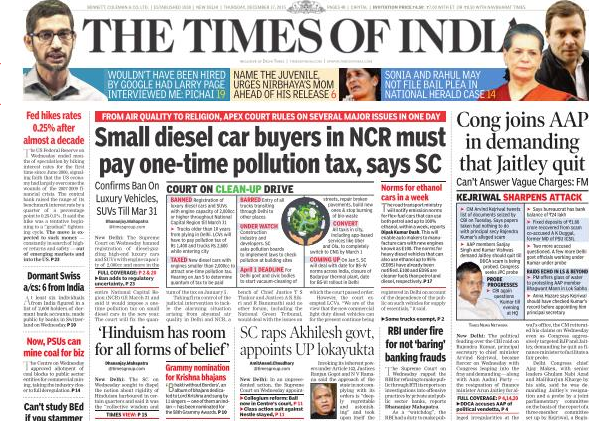
Wednesday was a case in point. While a small news piece buried in the middle of the Times of India on Thursday celebrated a brief period of actual performance by the Rajya Sabha, the rest of the newspaper seemed full of stories about the Supreme Court either taking action on an important issue or asking the government to do the same.
Since it’s hard to get a measure of just how stark the disparity is, here’s a rough but reliable way to point out the difference in action between the judiciary (in this case only the Supreme Court, not counting high courts or lower courts), and the legislature (in this case, only the Parliament, not legislative assemblies).
We looked only at the Delhi edition of the Times of India because it is, for what it’s worth, the country’s most-read newspaper and hence a paper of record. One may say the Delhi edition would be biased toward covering the Supreme Court since it is located there, but then so is Parliament.

The final result? Supreme Court: 15. Parliament: 4. There were 15 stories across the newspaper’s 28 pages dedicated to action taken by the Supreme Court compared to just four about Parliament. The nature of these stories drives the point home even deeper. There were as many stories about the Supreme Court on the paper’s front page as there were about Parliament across the entire newspaper.
And a close look at the four Parliement stories is even more revelatory. One is about a protest in the Lok Sabha. Another is about hope fading for a Bill. A third celebrates a brief period of performance. And finally, a brief talks about legislation that was actually passed.
Parliament coverage in Times of India, December 17 New Delhi edition
Page 14
Modi’s glass of water fails to quell fiery Mann in LS
RS works briefly as FM seeks assurance
Brief: LS approves bill on commercial courts
Page 17
With disability bill stuck in PMO, hope fades for its passage in House
The Supreme Court coverage, meanwhile, was all about things that the Supreme Court had done – or intended to do. On the front page alone, there were stories about attacking the pollution problem in the capital, on how temples are run, on appointing a Lokayukta in Uttar Pradesh after the state government didn’t do it and on attempting to clean up the banking industry. Aside from an editorial talking about the Supreme Court’s actions, most of the rest of the stories also focused on things the Supreme Court had done. There were Supreme Court stories on the front page, in the city pages, on the nation pages, on the business pages and even in the sports pages.
Supreme Court coverage in Times of India, December 17 New Delhi edition
Front page:
Small diesel car buyers in NCR must pay one-time pollution tax, says SC
‘Hinduism has room for all forms of belief’
SC raps Akhilesh govt, appoints UP Lokayukta
RBI under fire for not ‘baring’ banking frauds
Page 2
No leeway for construction industry
‘Vacuum clean roads from Apr 1’
Page 9
SC refuses to give Sanskriti any relief on student quota
Page 11
SC seeks reply from drought-hit states on supplying free gains
SC acknowledges govt role in judges’ selection
Class action suit against Nestle stayed
Page 15
Hinduism has no single founder or scripture: SC
Page 20
Editorial ” Fresh Answers”
Page 23
Banks are trying to cover up underhand actions: SC
Diesel vehcile ban adds to regulatory uncertainty
Page 28 (back page)
SC gives green signal to badminton league



